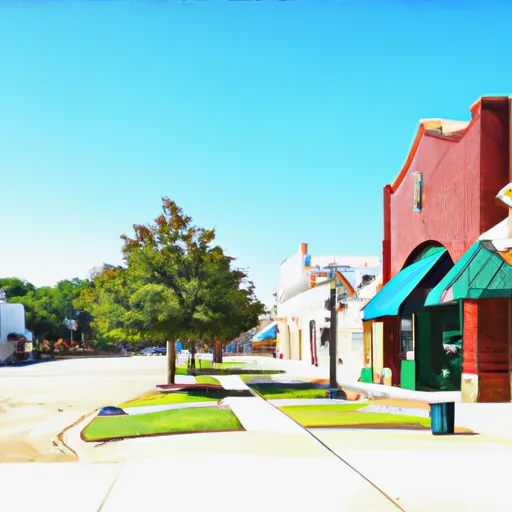-
 Snoflo Premium
Snoflo Premium
Get unlimited access to all our content
With no Ad interruptions! - Start Your Free Trial Login with existing account
Arcadia
Eden Index
Climate
7.5
•
Recreation
3.4
•
Community
3.7
•
Safeguard
5.1/10

Arcadia is a small town located in northeastern Texas. The climate in Arcadia is humid subtropical, with hot summers and mild winters. The town is situated near several bodies of water, including Lake Ray Hubbard and the East Fork Trinity River, which provide opportunities for fishing, boating, and other water-based activities. The hydrology constituents of the area are predominantly sandy soils and clay loam, with some sandstone formations. Outdoor recreational activities in Arcadia also include hiking and camping in the nearby nature reserves and parks, such as the nearby Lake Ray Hubbard Nature Park and the Trinity River Audubon Center. Overall, Arcadia offers a variety of outdoor activities for visitors and residents to enjoy.
What is the Eden Index?
The Snoflo Eden Index serves as a comprehensive rating system for regions, evaluating their desirability through a holistic assessment of climate health, outdoor recreation opportunities, and natural disaster risk, acknowledging the profound impact of these factors on livability and well-being.
Climate Health Indicator (CHI): 7.5
Arcadia receives approximately
1353mm of rain per year,
with humidity levels near 83%
and air temperatures averaging around
21°C.
Arcadia has a plant hardyness factor of
9, meaning
plants and agriculture in this region tend to thrive here all year round.
By considering the ideal temperature range, reliable water supplies, clean air, and stable seasonal rain or snowpacks, the Climate Health Indicator (CHI) underscores the significance of a healthy climate as the foundation for quality living.
A healthy climate is paramount for ensuring a high quality of life and livability in a region, fostering both physical well-being and environmental harmony. This can be characterized by ideal temperatures, reliable access to water supplies, clean air, and consistent seasonal rain or snowpacks.
Weather Forecast
Streamflow Conditions
Galveston Bay-Sabine Lake
Area Rivers
Galveston Bay-Sabine Lake
Snowpack Depths
Galveston Bay-Sabine Lake
Reservoir Storage Capacity
Galveston Bay-Sabine Lake
Groundwater Levels
Recreational Opportunity Index (ROI): 3.4
The Recreational Opportunity Index (ROI) recognizes the value of outdoor recreational options, such as parks, hiking trails, camping sites, and fishing spots, while acknowledging that climate plays a pivotal role in ensuring the comfort and consistency of these experiences.
Access to outdoor recreational opportunities, encompassing activities such as parks, hiking, camping, and fishing, is crucial for overall well-being, and the climate plays a pivotal role in enabling and enhancing these experiences, ensuring that individuals can engage in nature-based activities comfortably and consistently.
Camping Areas
| Campground | Campsites | Reservations | Toilets | Showers | Elevation |
|---|---|---|---|---|---|
| Wolf Creek Park - Lake Livingston | 100 | 195 ft | |||
| Camp Mohawk County Park | None | 23 ft | |||
| Ratcliff Lake | 72 | 383 ft | |||
| Rusk - Palestine Park | 71 | 447 ft | |||
| Mission Tejas State Park | 15 | 440 ft | |||
| Double Lake | 74 | 301 ft | |||
| Lake Houston Wilderness Park | None | 102 ft | |||
| Green Caye County RV Park | None | 13 ft | |||
| Lake Livingston State Park | 160 | 153 ft |
Nearby Fishing
Catastrophe Safeguard Index (CSI):
The Catastrophe Safeguard Index (CSI) recognizes that natural disaster risk, encompassing floods, fires, hurricanes, and tornadoes, can drastically affect safety and the overall appeal of an area.
The level of natural disaster risk in a region significantly affects safety and the overall livability, with climate change amplifying these risks by potentially increasing the frequency and intensity of events like floods, fires, hurricanes, and tornadoes, thereby posing substantial challenges to community resilience and well-being.
Community Resilience Indicator (CRI): 3.7
The Community Resilience Indicator (CRI) recognizes that education, healthcare, and socioeconomics are crucial to the well-being of a region. The CRI acknowledges the profound impact of these elements on residents' overall quality of life. By evaluating educational resources, healthcare accessibility, and economic inclusivity, the index captures the essential aspects that contribute to a thriving community, fostering resident satisfaction, equity, and social cohesion.

